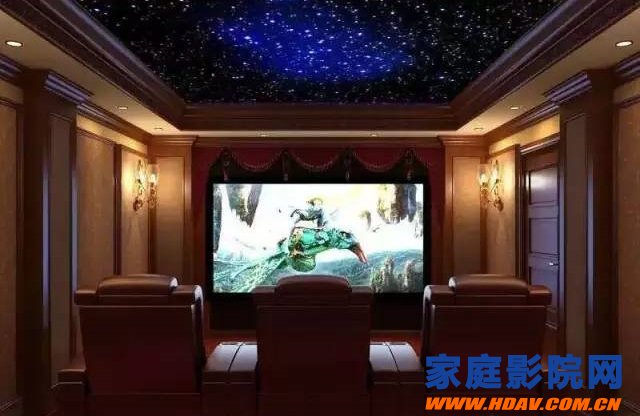[Home Theater Network HDAV.com.cn] If the cinema is the place to show the creative intentions of the film masters , then the private theater is the place where you can watch movies in your own home. With a professional private cinema, you don't need to worry about watching the movie schedule anymore. You don't have to feel the crowded public resources anymore. "Reverberation Time" is an acoustic term coined by Sabin, the father of modern architectural acoustics more than 100 years ago, and is an important parameter for home theater. After the indoor sound field is stabilized, the sound source stops sounding. The time taken from the moment until the sound energy density decays by 60 dB is called the reverberation time, that is, the time to one millionth of the original sound pressure stability value. The optimal reverberation time is based on long-term subjective experience and experience, not a fixed value, and the reverberation time required to appreciate different program types is different. If the reverberation time of the necessary home theater in the home theater reverberation process is too long, the sound emitted from the front of the sound source has not disappeared, and the sound that appears later is easy to make the bass roar, causing language dialogue, etc., focusing on the signal in the middle and high frequency bands. Decreased, even the sense of orientation disappears. If the reverberation time is too short, it will make the sound thin, dry, dull, lacking color and anger. Only when the reverberation time is moderate, the overall sound effect will be full, vivid, contagious and expressive. Therefore, it is very important to set the reverberation time reasonably. A large amount of data for reverberation time detection indicates that the reverberation time of the home audio-visual room is generally about 0.3 to 0.6 s. The calculation of reverberation time usually uses the formula: T=0.16V/α??T——reverberation time in seconds; V——audio room volume in cubic meters; α——indoor total sound absorption coefficient If you are interested, you can calculate your own home theater reverberation time and do a small test for your home theater! Home theater reverberation time processing 1. Design room size according to the reverberation time calculation formula??, in Before building a house, controlling the reverberation time of the home theater by changing the size of the room or reducing it is an excellent reverberation time control. When the reverberation time is required to be short, the room volume is appropriately reduced; when the reverberation time is required to be long, it is appropriate to increase the room volume. You can choose the reverberation time you want, and the designer calculates the best room size. Then design your favorite interior decoration. But today most users create home theater audio-visual rooms in the existing built environment. This can only be modified in the existing room size, designed with reasonable reverberation time. 2. Using acoustic materials to transform home theaters Nowadays, when people are looking for leisure, many people want to make a home theater at home, then you can't change the reverberation time from the perspective of room size. Designers need to consider acoustics. Material to change the reverberation time of the room surface. Professional building acoustic engineers measure the reverberation time of the room. If the reverberation time is too long, a variety of sound absorbing materials can be used to cover the surface of the room, increasing the overall sound absorption of the room and reducing the reverberation time. There are many types of sound absorbing materials, and there are different sound absorbing properties for sounds in different frequency bands. If the reverberation time is found to be too short, reflection and diffusion materials can be used to increase the length of the reverberation time. Since any material has a certain sound absorption characteristic, the same diffusion material can effectively diffuse sound, and can also absorb sound at a specific frequency. Of course, it should be noted that most acoustic companies currently adopt software simulation to develop an acoustic treatment scheme: on-site measurement or directly provide customers with long-width and high-level room type data, and develop an acoustic treatment scheme through software simulation. Because the reflection coefficient of the wall material is different, the actual low-frequency reflection of each wall is very different from that of solid brick, hollow brick or reinforced concrete wall. The software cannot judge and objectively analyze these situations. To provide you with a correct and scientific approach: use professional test equipment and monitor speakers with flat frequency curve to perform 20-20 kHz full-frequency analysis in the audio-visual space, obtain frequency indicators and then develop a targeted acoustic solution. . And don't just control the reverberation time unilaterally by sound absorption or diffusion treatment, but combine the sound absorption with the diffusion material to get a better reverberation time. Some people like sports cars, some people like famous horses, and there are also a few rich people who have a special liking for home theater. Just invest in it, the cost of building a top-class luxury home theater is even higher than that of a sports car, but the ultimate audio and video experience is not achieved by other means. In the leisure time, about two or three friends, it is a good idea to enjoy the wonderful time on the sofa. More fresh and fun home theater information, please pay attention to home theater network http:// (WeChat: cnhifi), the country's most influential home theater audio player interactive media website. Note: This article is transferred from the Shinkansen sound. The article is an independent view of the author and does not represent the position of the home theater network. Tomtom Battery,Tomtom Go Battery,Tomtom Start Battery,Tomtom GPS Battery Shenzhen Sunwind Energy Tech Co.,Ltd , https://www.sunwindbatterylm.com


March 23, 2021